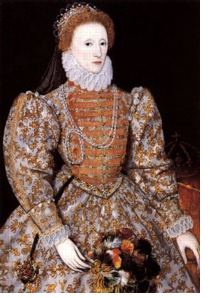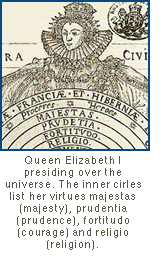Elizabeth I
Queen of England, b. 7 September 1533 (Greenwich, England), d. 24 March 1603 (Richmond).
 Elizabeth I was born into a difficult time of strong rivalries between the European powers. Her father, king Henry VIII, had ended the influence of the pope - who had refused him to divorce his first wife Catherine of Aragon - by establishing the protestant Church of England. But England was weak and militarily isolated, and Henry's action had turned the power struggle into a religious confrontation.
Elizabeth I was born into a difficult time of strong rivalries between the European powers. Her father, king Henry VIII, had ended the influence of the pope - who had refused him to divorce his first wife Catherine of Aragon - by establishing the protestant Church of England. But England was weak and militarily isolated, and Henry's action had turned the power struggle into a religious confrontation.
Elizabeth was the second daughter of Henry's second wife Anne Boleyn. The Catholic church, which did not accept divorce, considered Elizabeth an illegitimate child. The king, who had divorced Catherine because she only gave birth to a daughter, was still without a male heir and thought of another marriage. Elizabeth had not reached the age of 3 when he accused Anne Boleyn of adultery and treason and had her beheaded. He then had his marriage with Anne Boleyn annulled by act of parliament, which made Elizabeth's illegitimate status official (and Henry's accusation of adultery somewhat illogical).
In 1537 Henry's third wife Jane Seymour gave birth to a son, Edward, and Elizabeth was declared third in line for the throne. She lived at the court, received a thorough classical education in Greek and Latin, became fluent in French and Italian and was particularly well treated by Henry's sixth and last wife Catherine Parr.
When Henry VIII died in 1547 Edward was crowned England's new king. He was only 10 years old, and Edward Seymour was appointed protector of the country. Catherine Parr soon married Edward Seymour's brother, the lord high admiral Thomas Seymour, who developed ambitions to take his brother's place. But when Catherine died he was arrested for treason in 1549 and accused of plotting to marry Elizabeth, thus gaining control of the kingdom.
During long and humiliating investigations into her relationship with Seymour the 16 year old Elizabeth showed an exceptional ability for self-control under adverse circumstances; she showed no emotion when Seymour's beheading was reported to her.
Elizabeth's position became even more uncertain when the young king Edward died in 1553 and Elizabeth's elder sister Mary became queen. Mary, who was married to the Catholic king Philip II of Spain, was an ardent Catholic herself. Her determination to force the pope's authority on England created a climate of inquisition, terror and intrigue; many protestants were burnt at the stake.
The protestant Elizabeth was accused of association with activities of treason and arrested but escaped death when extensive interrogations did not produce proof. Throughout Mary's reign she was placed under observation and survived by showing outward loyalty without revealing her inner thoughts and emotions.
Mary died childless in 1558, and the country greeted Elizabeth's accession to the throne with jubilation. Now in control of the country, Elizabeth had to contend with a new problem - being a woman. The problem had gained even greater dimensions through her sister's reign of terror, which had led to pamphlets such as The First Blast of the Trumpet Against the Monstruous Regiment of Women of the Scottish preacher John Knox, who declared that "God hath revealed to some in this our age that it is more than a monster in nature that a woman should reign and bear empire above man."
Elizabeth, who from the very beginning of her reign was determined to exercise power, reform the government and stabilize the situation of the country, countered these arguments in three ways. She never showed her own feelings or emotions, thus avoiding all accusations of female willfulness; she accepted and used the theory of "the king's two bodies" developed by the lawyers of the crown; and she cultivated her relationship with her subjects as a relationship of love.
According to the crown lawyers Elizabeth's accession to the throne added a "body politic" to her "body natural." While the "body natural" might be feeble and with faults, her "body politic" was of timeless perfection. Elizabeth used this theory in her accession speech to justify her reign as the absolutist monarch from God's will: "I am but one body, naturally considered, though by his permission a Body Politic to govern."
Elizabeth's strategy to exploit her femininity by declaring her love for her subjects developed into a true personality cult during her lifetime. It allowed her to extract taxes and other concessions from a parliament that might have otherwise obstructed her reign. When parliament in 1601 showed determined opposition to royal monopolies, the queen declared: "I do assure you, there is no prince that loveth his subjects better, or whose love can countervail our love. There is no jewel, be it of never so rich a price, which I set before this jewel; I mean, your love: for I do more esteem of it, than of any treasure or riches."
The image of the Virgin Queen (only slightly tarnished by rumours about a long romantic affair) in love with her subjects allowed her to thwart all strategic marriage proposals from Catholic or Protestant princes of other European powers and gave her the opportunity to consolidate the administration and economy of her country.
Elizabeth and England were under constant threat from inside and outside. In 1569 a rebellion of Catholic aristocrats was put down by force. In 1570 Pope Pius V excommunicated Elizabeth and absolved her subjects from any oath of allegiance. A plot to assassinate Elizabeth was discovered in the following year. In 1580 Pope Gregory XIII proclaimed that it would be no sin to rid the world of her. Six years later another assassination plot implicated the Catholic Queen Mary of the Scots, who had fled Scotland 14 years earlier and lived in England as a guest of the crown; she was tried and beheaded in 1587.
 The final confrontation came in 1588. Catholic Spain under Philip II prepared a naval assault against the Protestant Netherlands, followed by the conquest of England. Elizabeth was usually extremely frugal with state finances (the only exception being her own wardrobe, which had to support her public image). But when news of the Spanish war preparations reached London she did not hesitate to finance a major strengthening of her navy. The decisive defeat of the Spanish armada in English waters in 1588, one of the most famous sea battles in history, secured England's position as a European power.
The final confrontation came in 1588. Catholic Spain under Philip II prepared a naval assault against the Protestant Netherlands, followed by the conquest of England. Elizabeth was usually extremely frugal with state finances (the only exception being her own wardrobe, which had to support her public image). But when news of the Spanish war preparations reached London she did not hesitate to finance a major strengthening of her navy. The decisive defeat of the Spanish armada in English waters in 1588, one of the most famous sea battles in history, secured England's position as a European power.
Economic difficulties and unsuccessful military campaigns in Ireland during her final years created some disillusionment, and advancing age made it increasingly difficult for Elizabeth to keep up the dazzling image of the Virgin Queen. Some years after her death Francis Bacon said of her that "she imagined that the people, who are much influenced by externals, would be diverted by the glitter of her jewels, from noticing the decay of her personal attractions." But her achievements have stood the test of time, and the late 16th century in England is rightly known as the Elizabethan era.
home
 Elizabeth I was born into a difficult time of strong rivalries between the European powers. Her father, king Henry VIII, had ended the influence of the pope - who had refused him to divorce his first wife Catherine of Aragon - by establishing the protestant Church of England. But England was weak and militarily isolated, and Henry's action had turned the power struggle into a religious confrontation.
Elizabeth I was born into a difficult time of strong rivalries between the European powers. Her father, king Henry VIII, had ended the influence of the pope - who had refused him to divorce his first wife Catherine of Aragon - by establishing the protestant Church of England. But England was weak and militarily isolated, and Henry's action had turned the power struggle into a religious confrontation. The final confrontation came in 1588. Catholic Spain under Philip II prepared a naval assault against the Protestant Netherlands, followed by the conquest of England. Elizabeth was usually extremely frugal with state finances (the only exception being her own wardrobe, which had to support her public image). But when news of the Spanish war preparations reached London she did not hesitate to finance a major strengthening of her navy. The decisive defeat of the Spanish armada in English waters in 1588, one of the most famous sea battles in history, secured England's position as a European power.
The final confrontation came in 1588. Catholic Spain under Philip II prepared a naval assault against the Protestant Netherlands, followed by the conquest of England. Elizabeth was usually extremely frugal with state finances (the only exception being her own wardrobe, which had to support her public image). But when news of the Spanish war preparations reached London she did not hesitate to finance a major strengthening of her navy. The decisive defeat of the Spanish armada in English waters in 1588, one of the most famous sea battles in history, secured England's position as a European power.